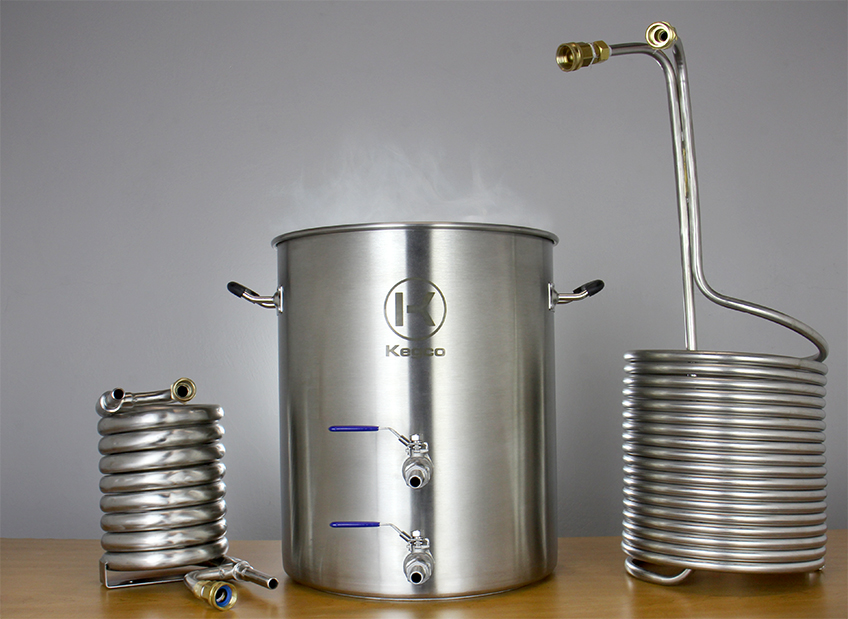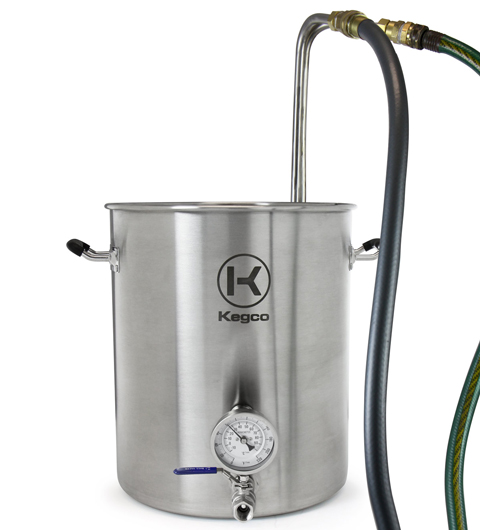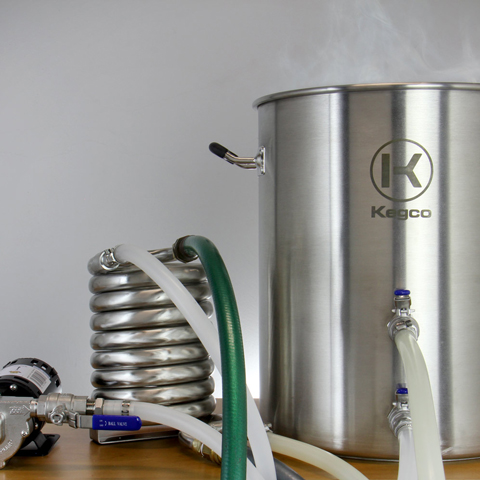
If you're a homebrewer progressing from smaller batches to much larger batches, you may find yourself looking for an alternative to ice baths for quickly chilling your wort. Quickly and effectively cooling your wort is vital to preventing infection, off flavors, and chill haze, so it is important to find the chilling solution that works best for you. Both immersion chillers and counterflow chillers will cool far more efficiently and effectively than an ice bath, but choosing which one works best for you can be a tough decision. Here are some helpful pros and cons to help you find your ideal chiller.

Immersion Chillers
An immersion chiller is a coil of metal (typically copper) that is immersed completely in the hot wort. It is hooked up to a sink or a garden hose and cold water is run through the coil to cool the wort.
Its low cost makes the immersion chiller great for homebrewers just starting out, and most applications do not require you to purchase a pump, so it is perfect for home brewers who do not wish to purchase many pieces of equipment. They can also be easily cleaned and sanitized, as the outer surface of the coil is the only part that comes into contact with the wort.
That said, immersion chillers do have their limitations. Because they only cool the wort that is touching the coils, you may need to stir your wort using a sanitized spoon or purchase a pump and a whirlpool arm in order to keep the wort moving and introduce as much surface area as possible to the cooling coils. Depending on the length of your coils, it may be difficult to efficiently chill larger batch sizes using your immersion chiller. 25' long, 3/8" I.D. coils are inexpensive, but not very efficient for anything more than a 5-gallon batch. A 50' long coil is a much better investment, especially when paired with a 1/2" I.D. coil because there will be much more heat transfer, bringing the temperature of the wort down more rapidly.

Counterflow Chillers
A counterflow chiller features a coil within a coil. The hot wort is pumped through the inner coil in one direction while cold water flows through the outer coil in the other direction to cool it.
When used properly, counterflow chillers have a very efficient design that can cool all of your wort with a single pass through, making them effective for batches of all sizes. For brewers graduating to larger and larger batch sizes as they advance, counterflow chillers will be able to keep up with the added volume.
The counterflow chiller's efficiency does come at a higher initial cost, and most applications require a pump. Most counter flow applications will be on a large brew stand that has a dedicated pump and valves for the counterflow system. Unlike an immersion chiller where the wort only comes into contact with the outer surface, wort travels through the inner coil of the counterflow chiller, making the cleaning and sanitation process more involved.
Copper vs. Stainless Steel
In addition to choosing what type of chiller you use, you'll also need to decide on what material its made of. You can find both counterflow and immersion chillers available in stainless steel and copper. Both materials have their advantages and drawbacks. Copper is the better choice for efficiency as it is a better conductor of heat than stainless steel while stainless is a less expensive material and easier to clean than copper.
In Conclusion
Every brewer's budget and brewing process is different, so neither chilling method is a better choice for everyone. When choosing between them, it is important to consider the kind of investments you're willing to make in your brewing equipment, the batch sizes you wish to brew both now and in the future, and what parts of the brewing process you want to put more or less effort into. Whichever method you decide on, Beverage Factory carries a high-quality chiller that will be perfect for you.


 Single Faucet Kegerator Beer Dispensers
Single Faucet Kegerator Beer Dispensers Dual Faucet Two Tap Kegerators
Dual Faucet Two Tap Kegerators Triple Faucet Three Tap Kegerators
Triple Faucet Three Tap Kegerators Undercounter Built-In Kegerators
Undercounter Built-In Kegerators Outdoor Kegerator Beer Dispensers
Outdoor Kegerator Beer Dispensers Commercial Kegerators
Commercial Kegerators Mini Kegerators
Mini Kegerators Cold Brew & Nitro Coffee Dispenser Kegerators
Cold Brew & Nitro Coffee Dispenser Kegerators Carbonated Water Kegerators
Carbonated Water Kegerators Home Brew Kegerators
Home Brew Kegerators 15" Kegerators
15" Kegerators Kombucha Equipment
Kombucha Equipment Guinness® Dispensing Kegerators
Guinness® Dispensing Kegerators Vending Kegerators
Vending Kegerators Wine Kegerators
Wine Kegerators Kegerator Cabinets
Kegerator Cabinets Kegerator Covers and Accessories
Kegerator Covers and Accessories Kegerators
Kegerators Kegerator Conversion Kits
Kegerator Conversion Kits Kegs & Keg Accessories
Kegs & Keg Accessories Beer Faucets
Beer Faucets Beer Shanks
Beer Shanks Draft Beer Towers
Draft Beer Towers Keg Taps Couplers
Keg Taps Couplers Regulators & Gas Equipment
Regulators & Gas Equipment Beer & Gas Line Hose
Beer & Gas Line Hose Co2 and Nitrogen Air Tanks
Co2 and Nitrogen Air Tanks Beer Line Cleaning Equipment
Beer Line Cleaning Equipment Drip Trays
Drip Trays System Fittings
System Fittings Jockey Boxes
Jockey Boxes Keg Beer Party Pumps
Keg Beer Party Pumps Glassware & Accessories
Glassware & Accessories Guinness® Dispensing Equipment
Guinness® Dispensing Equipment Remote Glycol Systems
Remote Glycol Systems Wine Cooler Refrigerators
Wine Cooler Refrigerators Wine Cellar Cabinets
Wine Cellar Cabinets Wine Racks
Wine Racks Cooling Units
Cooling Units Wine Dispensing Systems
Wine Dispensing Systems Wine Glasses
Wine Glasses Wine Accessories
Wine Accessories Howard Miller Wine & Spirits Furniture
Howard Miller Wine & Spirits Furniture Wine Making
Wine Making Nitro Hot Draft System
Nitro Hot Draft System Ready to Drink Bag-in-a-Box Coffee Dispensing Equipment
Ready to Drink Bag-in-a-Box Coffee Dispensing Equipment Nitrogen Infusers
Nitrogen Infusers Nitrogen Tanks & Generators
Nitrogen Tanks & Generators Nitrogen Beer Regulators
Nitrogen Beer Regulators Nitro Cold Brew Coffee Kegs
Nitro Cold Brew Coffee Kegs Cold Brewed Coffee Tools
Cold Brewed Coffee Tools Espresso Machines
Espresso Machines Cleaning Equipment
Cleaning Equipment Outdoor Appliances
Outdoor Appliances ADA Appliances
ADA Appliances Panel Ready Appliances
Panel Ready Appliances Commercial Grade Appliances
Commercial Grade Appliances Beverage Centers
Beverage Centers Refrigerators
Refrigerators Drawer Refrigerators
Drawer Refrigerators Ice Makers
Ice Makers Water Dispensers & Accessories
Water Dispensers & Accessories Freezers
Freezers Home Brew Equipment Kits
Home Brew Equipment Kits Fermentation Equipment
Fermentation Equipment Boiling and Mashing Equipment
Boiling and Mashing Equipment Home Brew Beer Kegs
Home Brew Beer Kegs Home Brew Kegerator Conversion Kits
Home Brew Kegerator Conversion Kits Brewing Tools
Brewing Tools Home Brew Ingredients
Home Brew Ingredients Cleaning Chemicals
Cleaning Chemicals Test Equipment
Test Equipment Home Brew Beer Bottles and Bottling Equipment
Home Brew Beer Bottles and Bottling Equipment Brewery Fittings
Brewery Fittings Draft Beer Equipment
Draft Beer Equipment Homebrewing Equipment
Homebrewing Equipment Wine Equipment
Wine Equipment Luxury Appliances and Refrigeration
Luxury Appliances and Refrigeration Coffee Equipment
Coffee Equipment Home Bar & Barware
Home Bar & Barware Kombucha
Kombucha The Beverage Blog
The Beverage Blog Frequently Asked Beer Questions
Frequently Asked Beer Questions Shop by Brand
Shop by Brand Shop by Category
Shop by Category



